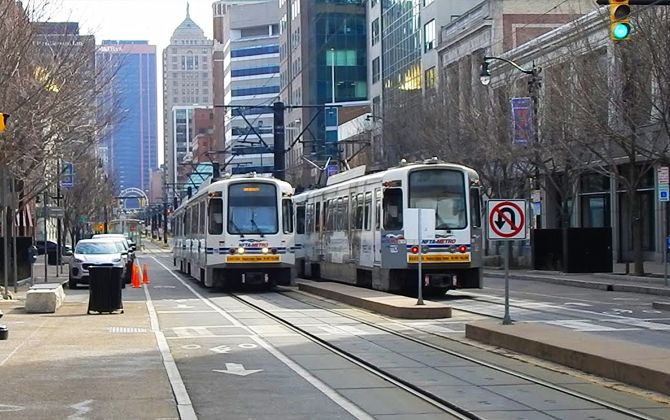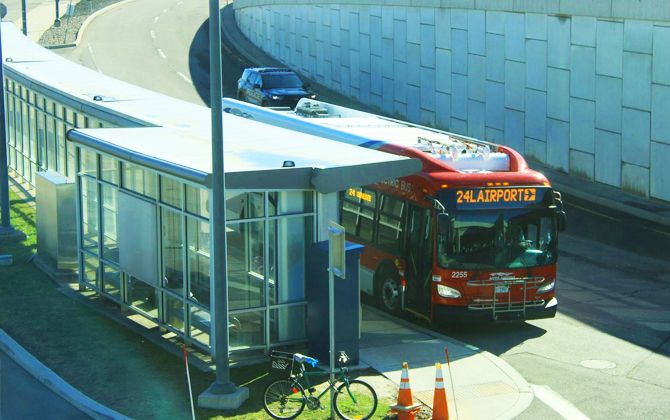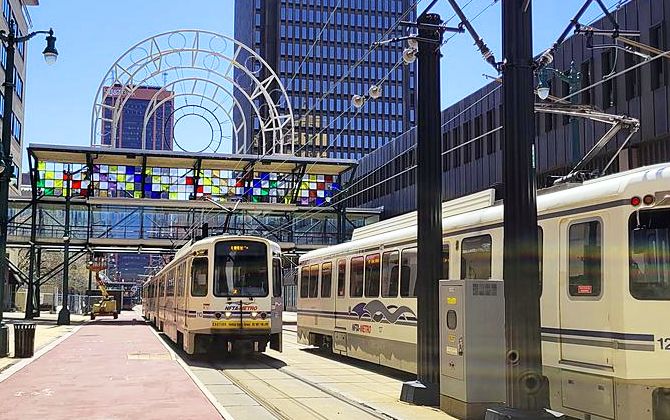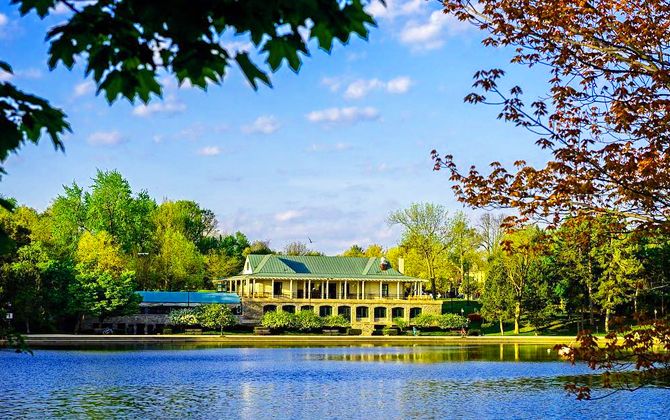Buffalo Metro Rail is a single-line light rail system operated by the NFTA. The line runs north–south for about 6.4 miles (10.3 km) along Main Street in Buffalo, connecting the University at Buffalo South Campus (University Station) with the Canalside/KeyBank Center area (Special Events/Canalside).
The system has 13 active stations, with one more planned at the future DL&W terminal. As of 2026, it serves about 8,900 riders on weekdays.
Most of the route—around 5.2 miles (8.7 km)—is in tunnel. The remaining 1.2 miles (1.9 km) run at street level through downtown. The line opened in stages between 1984 and 1986 and was built to rapid-transit standards.
Metro map of Buffalo
Updated Metro Rail map for 2026, available in PDF format and posted at all stations. The line runs mainly along Main Street, with underground sections downtown and surface-level tracks through the entertainment district.
Map of Buffalo Metro showing different lines. Click on the map to enlarge it or download the Buffalo Metro map in PDF format.
Lines and Stations
Buffalo’s Metro Rail has a single line. It starts at University Station (UB South Campus, opened 1986) and runs south to Canalside (Erie Canal Harbor). A nearby Special Events platform serves KeyBank Center during games and concerts. The stations, north to south, are:
- University – UB South Campus, underground terminus. Major hub with 11 bus connections.
- LaSalle – underground, one stop south of University.
- Amherst Street – underground, near the zoo and Delaware Park. Temporary terminus in 1985–86.
- Humboldt–Hospital – underground, serving Buffalo Zoo and medical offices.
- Delavan/Canisius University – underground, near Canisius College. Known for its long escalators.
- Utica – underground, transit hub at Main & Utica. Renamed “Robert T. Coles Utica” in 2021.
- Summer–Best – underground, serving Allentown and Allied Health area.
- Allen/Medical Campus – underground, near the Medical Campus. Last paid station before the free-fare downtown zone.
- Fountain Plaza (Huron) – at-grade, central downtown theater district. Opened in 1984, replaced the closed Theater station in 2013.
- Lafayette Square – at-grade, near City Hall. Sponsored by Evans Bank.
- Church Street – at-grade, downtown Free Fare Zone. Currently closed for renovation.
- Seneca – at-grade, near Sahlen Field. Sponsored by Merchants Insurance.
- Canalside (Erie Canal Harbor) – at-grade, across from KeyBank Center. Rebuilt and reopened July 2024. Connected by pedestrian tunnel to Buffalo–Exchange Street Amtrak station.
- Special Events (Arena) – limited-use stop on Perry Street by KeyBank Center. Open only during events.
- (Future) DL&W Terminal – under construction in the historic DL&W train shed, set to replace Special Events station. Opening planned for late 2024.
Buffalo Metro Rail Schedule
Metro Rail trains run daily from about 6:00 AM until midnight, with slightly later service on weekend nights.
During weekday rush hours, trains arrive about every 10 minutes.
Midday and evening service is every 15–20 minutes.
Trains turn around at University Station, so frequency is the same at all stations along the line.
Fares and Tickets
The Metro Rail uses a proof-of-payment system. Tickets and passes must be purchased before boarding, either at ticket machines or through the MetGo app. Standard fares are:
| Ticket Type | Price (USD) |
|---|---|
| Single Ride (adult) | $2.00 |
| Unlimited Day Pass | $5.00 |
| 7-Day Pass | $25.00 |
| 31-Day Pass | $75.00 |
| Reduced Fare* (single) | $1.00 |
| Reduced 7-Day | $12.50 |
| Reduced 31-Day | $37.50 |
*Reduced fare applies to seniors (65+), persons with disabilities, Medicare recipients, and youth ages 6–18. Children under 6 ride free with an adult.
Travel within the downtown Free Fare Zone (Church, Seneca, Canalside–Fountain Plaza) is free. Trips north of Fountain Plaza require a paid fare.
Connections
Most Metro Rail stations connect to Buffalo’s bus network. Key transfer points include:
- University Station – hub with 11 bus routes (5, 8, 12, 13, 19, 34, 44, 47, 48, 49, 81). Features a large bus loop.
- Allen/Medical Campus – served by routes 7, 8, 29, 64, 66, 67. Connects the Medical Campus and downtown.
- Utica Station – bus loop for routes 8, 12, 13, linking west and east Buffalo.
- Delavan/Canisius University – bus loop for routes 8, 18, 26, 29. Connects north Buffalo and Tonawanda.
- Summer–Best – curbside stops for routes 8 and 22.
- LaSalle – curbside stop for route 8 Main.
- Humboldt–Hospital – curbside stop for route 8.
Other downtown stations (Lafayette, Fountain Plaza, Church, Seneca, Canalside) are close to many bus routes, including lines serving the suburbs.
Connection to the Airport
Buffalo Niagara International Airport (BUF) is not on the Metro Rail line. Instead, NFTA Route 24 (Genesee) “Airport–Downtown Express” provides a direct link. It stops near Lafayette Square and the Central Terminal. The ride between downtown and the airport takes about 20–30 minutes, depending on traffic.
Rules
- While waiting for the train, whether at a bus stop or underground station, keep a safe distance from the yellow line. Also, before boarding a train, allow other passengers on the train to disembark first.
- Seats at the front of trains are reserved for disabled people, pregnant women and the elderly. Avoid sitting on these seats.
- If you are unable to find a seat while travelling on Buffalo’s trains and buses, do not block the doors or lean against them. Doing so could be dangerous to yourself and create an obstruction for other passengers. If you can’t find a seat, grab a seat belt or handrail to prevent falling.
- Do not eat, drink or smoke while travelling on city trains and buses.
- If you play multimedia content on your mobile device, use headphones to avoid disturbing other passengers.
- The only animals allowed on the system’s trains and buses are guide dogs, which must be properly identified.
- If, for any reason, one of your belongings falls on the metro tracks, be very careful when picking it up and make sure that no trains are coming.
- Children under the age of five should be accompanied by a parent or guardian to avoid emergency situations.
- Wait carefully until the train has come to a complete stop. Do not try to board the train while it is still moving.
- If you have a pushchair, go to the first or last carriage and then walk to the end of the train. This way you will not disturb other passengers.
- Be aware of the space between the trains and the platform, if you get stuck in this space you could be in a very dangerous situation.lo.
History
Planning for Buffalo’s subway started in the 1960s. The first 6.4-mile (10.3 km) segment opened on October 9, 1984, between Special Events (Downtown Arena) and Erie Canal Harbor. It was extended north on May 18, 1985, to Amherst Street, and on November 10, 1986, to University Station.
In 2003, the Downtown Arena stop was renamed Special Events. Theater station, located between Fountain Plaza and the tunnel, was closed on February 17, 2013, with Fountain Plaza taking its place as the downtown terminus. Since then, Metro Rail has seen modest ridership growth, but no new extensions have been built—the line remains the same length as in 1986.
Original 1970s plans proposed branches to Tonawanda/Niagara Falls and to the airport, but these were never built.
Future Expansions
The NFTA is pursuing several expansion projects. The highest priority is the University–Amherst–Tonawanda corridor. In 2026, NFTA released a Draft Environmental Impact Statement for this project, which would extend high-frequency light rail or bus rapid transit from University Station north through Amherst to UB North Campus and Tonawanda.
The plan includes 10 new stations, a travel time of about 14 minutes between University and UB North, and service every 5–10 minutes at peak. Construction has not yet been funded.
Another near-term project is the DL&W Terminal station in the historic Lackawanna Terminal building, one block south of Special Events. This new station will replace the existing Special Events platform. Originally scheduled for 2023, it is now expected to open in late 2024. Once complete, Special Events will close and trains for KeyBank Center will serve DL&W instead.
Other possible routes, such as to Niagara Falls Airport or the Niagara Falls corridor, have been discussed but are not moving forward at this time.
Touristic Attractions
The Metro Rail gives visitors easy access to many of Buffalo’s main attractions:
- University / LaSalle / Amherst – Near the Darwin D. Martin House (Frank Lloyd Wright, National Historic Landmark) and Delaware Park. The Buffalo Zoo and the University at Buffalo South Campus are also nearby.
- Humboldt–Hospital – Close to the Allentown neighborhood, known for historic homes, restaurants, and nightlife. Also near the Buffalo Medical Campus.
- Allen–Medical Campus – Gateway to the Buffalo Niagara Medical Campus. Within walking distance of the Anchor Bar, birthplace of Buffalo wings. The Allentown arts and bar district is to the west.
- Fountain Plaza – In the Theater District, home to Shea’s Performing Arts Center, Alleyway Theatre, shops, and restaurants.
- Lafayette Square – Next to Buffalo City Hall and the Central Library. Lafayette Park hosts many downtown events.
- Church – Near the Buffalo Metropolitan Transportation Center (main bus hub). Walking distance to the waterfront and the Naval & Military Park.
- Seneca – On the edge of the waterfront. Close to Sahlen Field (Buffalo Bisons baseball), Seneca One Tower, and the Erie County Naval & Military Park.
- Canalside (Erie Canal Harbor) – The city’s main waterfront district. Attractions include the Naval & Military Park, KeyBank Center (NHL arena), and HarborCenter complex. The Buffalo–Exchange Street Amtrak station is adjacent, linked by a pedestrian tunnel under I-190. Canalside hosts festivals, concerts, ice skating, and museums.
Metro Rail is a convenient way for visitors to reach these sites, with Canalside especially popular for tourists arriving by train or attending Sabres games.
Fun Facts
- The Metro Rail is 6.4 miles (10.3 km) long and has 13 stations. Most of it was built underground in the 1980s.
- The fleet includes cars numbered 101–127. Trains can reach 50 mph (80 km/h) but usually operate around 15 mph (24 km/h).
- Station naming rights: Lafayette Square is officially “Evans Bank @ Lafayette Square.” Seneca Station is “Merchants Insurance @ Seneca” (since 2019).
- Delavan/Canisius University Station has one of the longest escalators in the U.S., stretching over 100 feet (30 meters).
- Utica Station was renamed in 2021 after Robert T. Coles, the local architect who designed it.
- The six downtown stations (Fountain Plaza through Canalside/Special Events) form a Free Fare Zone for northbound riders.
- The future DL&W Terminal will reopen the historic 1917 Lackawanna Station, transforming its passenger hall into a modern Metro Rail stop.





